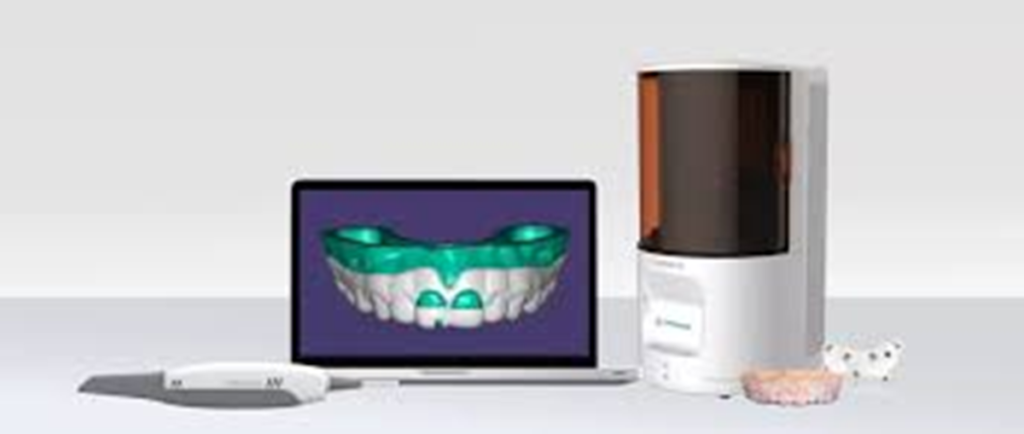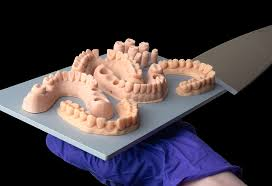3D printers for dental crowns have revolutionized the process of creating 3D-printed dental crowns. Dentists and professionals can now produce customized, accurate 3D printed dental crowns with increased precision and speed. The possibilities and benefits of 3D printed dental crowns are limitless, especially when you use cutting-edge technology like Aidite CPD-100 DLP 3D printer for dental crowns.
The article below is a comprehensive guide to 3D printer for dental crowns and describes the benefits of 3D printing dental crowns. You will be able to use a dental 3D printer for crowns more accurately after reading the full article.
Let’s start without wasting a moment and learn about 3D printers for dental crowns and the benefits of 3D printing dental crowns.

What is a 3D Printer For Dental Crowns
A 3D printer for dental crowns is the latest technology device that uses additive manufacturing technology to create dental restoration, crowns, and veneers. The innovation of 3D printed dental crowns has simplified the process of converting digital design into physical output as compared to traditional methods. Dentists can craft highly precise customized crowns and enjoy the unlimited benefits of 3D printing dental crowns. The best 3d printers for dentistry like Aidite CPD-100 DLP delivers unparalleled efficiency during the process of crafting dental restorations.
Benefits of 3D Printed Dental Crowns
Some of the most common benefits of 3D printed dental crowns are listed below for your understanding.
- These are a cost-effective solution for creating crowns
- A 3D printer for dental crowns offers a quick and easy production process
- High-quality and durable restoration
- It offers enhanced patient comfort and satisfaction
- 3D printed dental crowns are more accurate
- The 3D printers are easy to use and maintain for the professionals
Types of Dental 3D Printer For Crowns
Some of the most common benefits of the best 3d printers for dentistry are listed below for your understanding.
Stereolithography (SLA)
This type of dental 3D printer for crowns uses a laser to process the liquid resin and turn it into solid layers with smoothness and exceptional accuracy. This method is perfect for crafting complex designs and detailed restorations. The SLA printers are a popular choice for dental labs with their ability to deliver high-resolution results.
Digital Light Processing (DLP)
The digital light processing 3D printers for dental crowns employ a digital projector for processing the entire resin. This technology offers increased processing speed with detailed results and high accuracy. The DLP offers an efficient and cost-effective solution for producing multiple crowns in less time.
Selective Laser Sintering (SLS)
The SLS Dental 3D printer for crowns uses a laser to process material, specifically nylon and metal, for creating crowns. This technology is best for producing dental crowns for rough and long-term use. The selective laser sintering 3D printer for dental crowns is the most suitable option for high strength and complex design.
Best 3D Printers For Dental Crowns
There are too many 3D printers for dental crowns available in the market, and it is hard to find the best out of them. Here we offer you the solution by describing the top 3 best dental 3D printers for crowns to find the best 3d printers for dentistry.
Aidite: CPD-100 DLP 3D Printer
The CPD-100 DLP Printer is a 3D printer manufactured by Aidite that is ideal for single crowns, connected bridges, veneers, and restoration cases. This 3D printer has built-in AI optimization to perfectly match motor operation and optical machine exposure time. It prints at speeds up to 26 mm/hour at 0.5 mm thickness. It delivers fast, reliable, high-quality printing to increase productivity and precision in your dental lab and clinic.

Function:
- Ultra-Precision Printing: CPD-100 achieves 30 micron accuracy, allowing the printed model to fit the surgical area perfectly when using a 3D printer for dental crowns. It is a high-precision dental model that you need for dental surgery.
- AI function: This 3D printer for dental crowns has AI tuning, which promotes the improvement of production efficiency and shortens the printing time, making it one of the fastest dental 3D printers on the market.
- Durability:The CPD-100 is a high-precision 3D printer for dental crowns designed to last for up to 3,000 hours, ensuring long-term stable performance, making it an affordable investment for dental professionals.
Note: Among these three 3D printers for Dental Crowns, I would recommend Aidite’s CPD-100 DLP 3D Printer the most. It is the most cost-effective of the three, has excellent functions and practicality, and can meet your surgical needs. The following are user reviews of Aidite’s CPD-100 DLP 3D Printer, which may be the real reason why it is loved by users.
“We’ve been using the CPD-100 for orthodontic repairs, and the results are fantastic. The accuracy and speed make it indispensable in our clinic. It’s efficient and reliable.
—-Dr.Emily,Orthodontist, USA
Reviews of Aidite 3d printers for dental crowns: https://www.glassdoor.co.in/Reviews/Aditi-Consulting-Reviews-E710372.htm
Form 3B:
The Form 3B dental 3D printer for crowns is manufactured by Formlabs and is an SLA printer with 25-micron precision and 250MW laser power. It is an easy-to-use and operate printer with a build platform of 145 x 145 mm. The printer offers different connectivity options including Wi-Fi, USB, Ethernet, and a built-in heat.
Function:
- Biocompatibility: These 3D printers for dental crown are compatible with a wide range of FDA-registered, ISO 13485-approved biocompatible resins to meet the medical needs of surgical guides and orthodontic appliances.
- Automated Resin Management: The cassette design of these 3D printers for dental crown enables overflow-free automated dosing, reducing costs and simplifying maintenance.
- Multiple sensors for real-time monitoring: These 3D printers for dental crown integrate infrared heat and temperature sensing, ultrasonic level detection, and an internal camera to dynamically optimize the printing environment and improve the consistency and reliability of the finished product.
DENTIQ:
The DENTIQ 3D printer for dental crowns is designed by Ackuretta company and offers a user-friendly solution with high quality and precision. This printer simplifies the process of creating temporary crowns, splints, and in-house dental models. It is the perfect option for professionals looking to maintain consistency and enhance their work efficiency.
Function:
- Auto‑Calibration and Rapid Setup: The DENTIQ ships precalibrated with automatic Z‑axis calibration and a plug‑and‑play workflow, enabling clinicians to go from unboxing to first 3D printer for dental crowns print in under 30 minutes.
- Precision: These 3D printers for dental crowns features a 47 μm pixel‑size screen for exceptionally smooth surfaces and ultra‑precise fits—critical for restorations produced by 3D printers for dental crowns, splints,and surgical guides.
- Biocompatible Compatibility: Prevalidated for over 150 premium, biocompatible resins (including temporary crown, splint, and model materials), the DENTIQ 3D printer for dental crowns ensures consistent material performance across diverse dental applications.
How to Use a Dental 3D Printer For Crowns
It is fundamental for all dentists and professionals to learn how to use dental 3D printers for crowns. The whole process is described in the steps below for you to effectively learn and understand how to use a dental 3D printer for crowns.
Step 1: Scanning and Patient Preparation:
The first step in how to use a dental 3D printer for crowns is patient preparation and digital scanning of the patient’s oral structure. You need to use high-resolution devices for the intraoral scan of the natural teeth and surrounding tissues. The digital scan offers a comfortable experience for patients as compared to the traditional scan molds. Once the scan is completed, all the data is converted into a digital file for designing the crown.
Step 2: Designing the 3D Printed Dental Crown
After completing the scan process, the next step is to design the crown using CAD or CAM software. This software offers the dentist the ability to customize the shape, contour, and size of the crown for perfect alignment. You also need to consider the aesthetics of the crown in the designing process for seamless matching of the crown with the natural teeth of the patient.
Step 3: Printing of the Crown
Printing of the 3D printed dental crowns starts after the design is prepared. Firstly, you have to set up the printer by selecting the appropriate setting and resin material for optimal performance. After setting up, the design file is loaded into the dental 3D printer for crowns to start the layer-by-layer printing process. You can use a DLP, SLA, or SLS printer according to the material and your needs. Proper monitoring is necessary to ensure dimensional accuracy and structural integrity of the 3D printed dental crown.
Step 4: Post-Processing the 3D Printed Dental Crown
Post-processing is the final step of how to use a 3D printer for dental crowns. In this step, you have to properly wash the crown to remove any residual resin with the help of a cleaner. After thorough cleaning, cure the restoration under UV light to strengthen and harden its surface for extra durability. Once the curing is done, polish the surface of the crown to achieve a smooth and aesthetic surface.

FAQs
1. How much time does a 3D printer for dental crowns need to design a crown?
The amount of time and printing process depends on the complexity of the design and the printer. Commonly, a printer can design a 3D printed dental crown within an hour.
2. Which dental 3D printer for crowns is the best for all types of material?
The Aidite’s CPD-100 dental 3D printer is the best option for processing all types of resin material and crown design.
3. Do 3D printers for dental crowns require special skills to operate?
The modern dental 3D printers for crowns are easy to use and don’t require much professional training. You can learn how to use a dental 3D printer for crowns by following the steps described above in the article.
4. How much does it cost to 3D print a crown?
The average cost is about $500 to $1,500 per crown. If you want to know more, please visit Aidite’s dental 3D Printer price, which can help you learn more about 3D printers for dental crowns and meet your needs in the dental industry.
Conclusion
The innovation of 3D printers for dental crowns has revolutionized the process of creating crowns in a precise and cost-effective way. The professionals can enhance their workflow and quality by investing in dental 3D printers for crowns. They can craft highly durable and long-lasting 3D printed dental crowns by learning to use a 3D printer for dental crowns. Aidite is able to meet all your requirements, and its 3D printers for dental crowns such as the CPD-100 have become a benchmark in the field of dental restorations with unparalleled speed and precision. Aidite leads the development of the dental industry with its reliable products and innovative solutions for various dental procedures.



